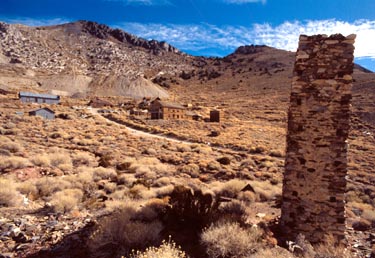|
Nestled high in the Inyo Mountains east of the Sierra Nevadas, at an altitude of 8,500 feet, Cerro Gordo, Fat Hill, was discovered to be rich in silver deposits by a group of Mexican miners led by Pablo Flores. The year was 1865. By 1866, Victor Beaudry, a French Canadian, now a merchant at Fort Independence in Owens Valley, realized there were opportunities at the Cerro Gordo mining camp, and opened a general store on the mountain. He began acquiring mining properties in lieu of overdue accounts and by January of 1868 arranged with Pierre Desormeaux to build ore furnaces. By April of 1868, Beaudry acquired more properties which included the richest claims on the hill, the Union, the San Lucas, the San Felipe and more.

That same April that Victor Beaudry claimed more and more properties around Cerro Gordo, Mortimer Belshaw came in to town. He became part owner of the Union Mine, as well. June 1868, Belshaw processed ore in one of the Mexican furnaces, then brought the first wagon load of silver into the sleepy pueblo of Los Angeles. He built the Yellow Grade road from Owens dry lake to Cerro Gordo, in July of 1868, so equipment could be taken to the mines, and the ore taken down the mountain. He also built his own smelters to process that ore, in much larger volumes than Victor Beaudry was capable of. By December of 1868, regular shipments of silver bullion were going to Los Angeles. Silver ingots 18 inches long, and weighing 85 pounds, were worth from 20-35 dollars. Cerro Gordo was being hailed as another Comstock.
In 1869, the Owens Lake-Silver Lead company provided competition for Mortimer
Belshaw's smelters, and built two blast furnaces on the shore of the Owens Lake, below the Inyo Mountains where Cerro Gordo was situated. That same year, Remi Nadeau, another French Canadian, won the 3 year freighting contract to deliver bullion from Cerro Gordo, to Los Angeles. His trade helped to turn Los Angeles into what it is today.
By the early 1900's silver prices dropped, and the once booming Fat Hill was dying down. In 1910 L.D. Gordon began extracting zinc ore, and production was resuming once again. New deposits of silver were found in the mines, as well as lead. In the years that followed, buildings were refurbished, electricity came to town, and for a time the town continued on.

As time passed mining ceased completely at Cerro Gordo. The town literally turned into a ghost town. In the early 1970's, Jody Stewart, a native of Inyo County, bought part ownership in the town from an uncle who was left as caretaker. The story, as Jody would tell it herself, was that she worked in Hollywood, for the game show Password, when her uncle called and asked for her help. She drove up the Yellow Grade Road in her sports car; I believe Jody said it was a Porsche. She climbed out of that car in her high heels and her fur coat, and her uncle took her around and told her about the Fat Hill. She fell in love with the place, and became a part of its history. In 1984, she took full ownership of the town and moved into the L.D. Gordon House. She restored the Belshaw House, and the bunk house for guests to stay in. The Beaudry General store was turned into a museum of original mining day artifacts, and the downstairs of the American Hotel was opened for occasional banquets and meals. The town is billed as the only bed and cook your own breakfast, ghost town in the world.
During the summer months, Zion Youth Camp is run at Cerro Gordo. Weekends, and the rest of the year, visitors can stay in town, take tours, and photographs, hunt for rocks and minerals, and soak in the history and beauty of this old silver mining town. Jody passed away in December of 2001, but her many friends, and current caretakers, John and Roxie Bowden help to keep her dreams and restoration efforts alive.
There are many ghost stories connected with the old Fat Hill. The most prevalent is the story of Alphonse Benoit, the Ghost of the Inyos. He was apparently a woodcutter at a nearby lumber camp during the towns heyday. After he was murdered, his ghost still walked the Inyos. If you are lucky enough when you stay at Cerro Gordo, you can see him in the kitchen window of the American Hotel. Pictures of his appearance in the window, are in the photo album available to view in the lobby. Family and volunteers who have been privileged enough to sleep upstairs in the hotel, often hear his footsteps walking up and down the rickety old stairs.
Bibliography
From This Mountain - Cerro Gordo
by Robert C. Likes & Glenn R. Day
Community Printing & Publishing, Bishop
Back
to Cerro Gordo Page
|

